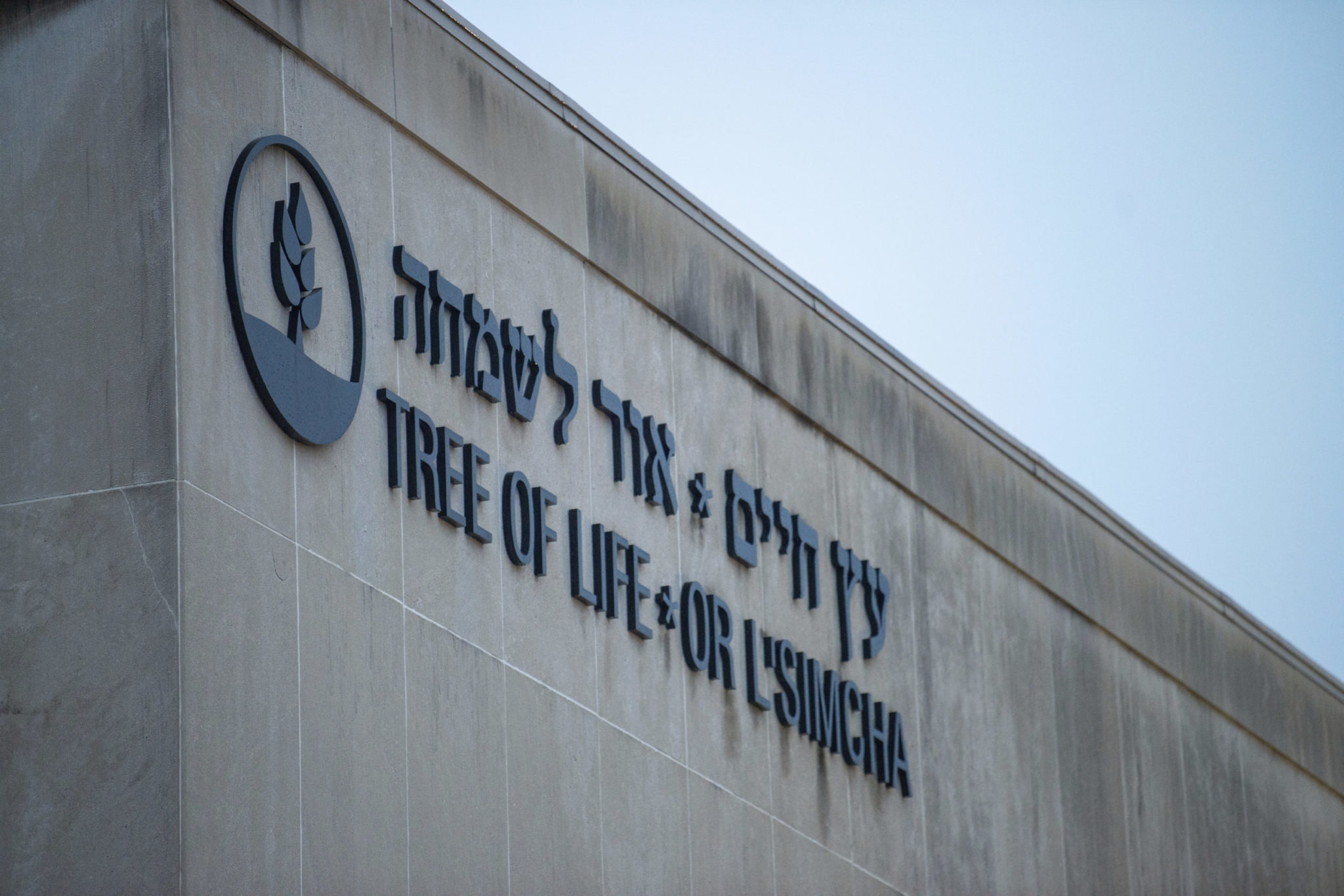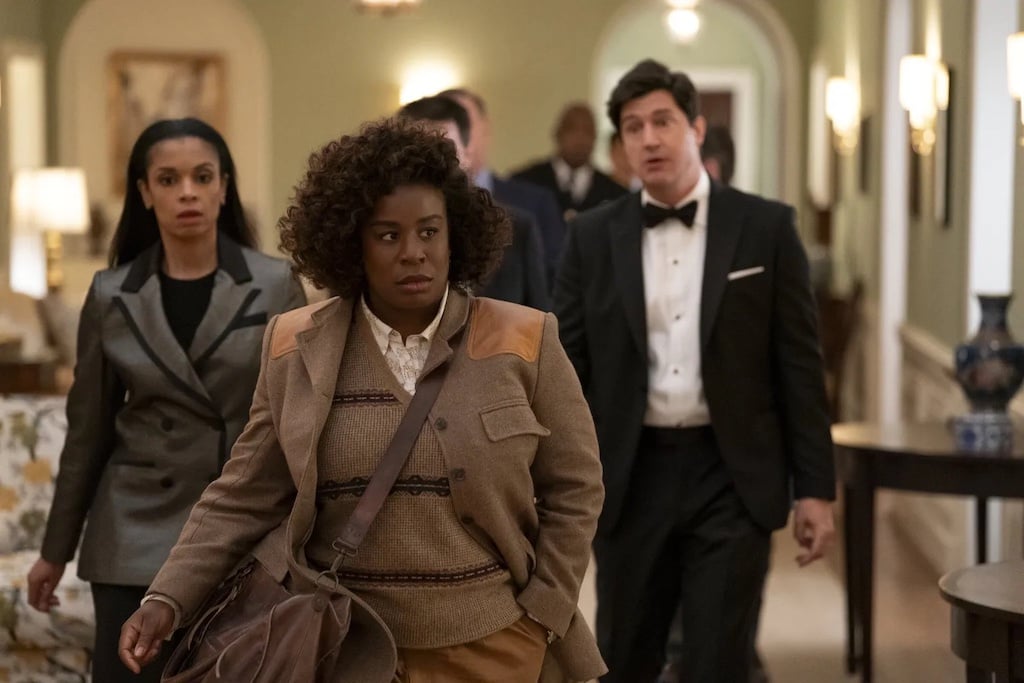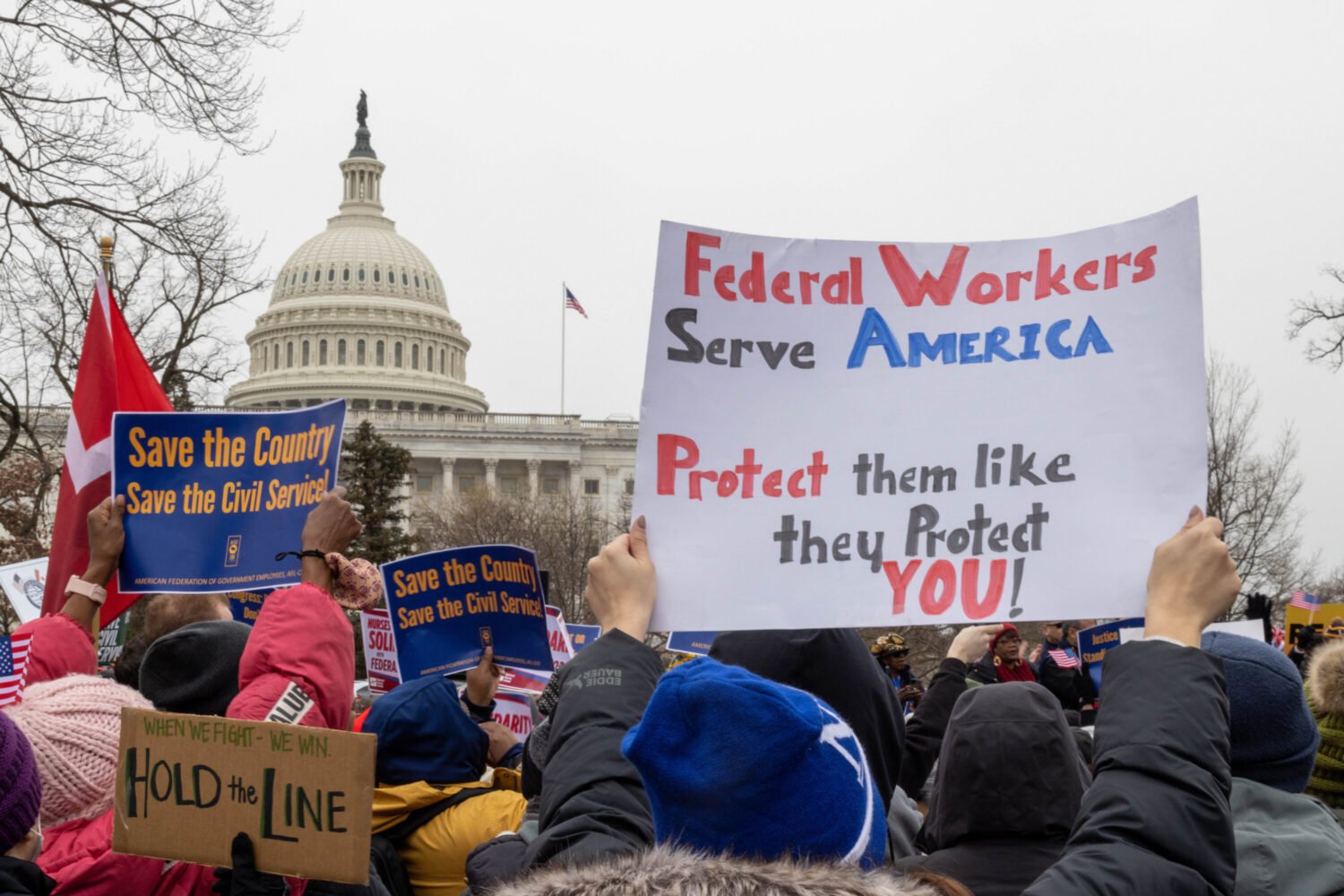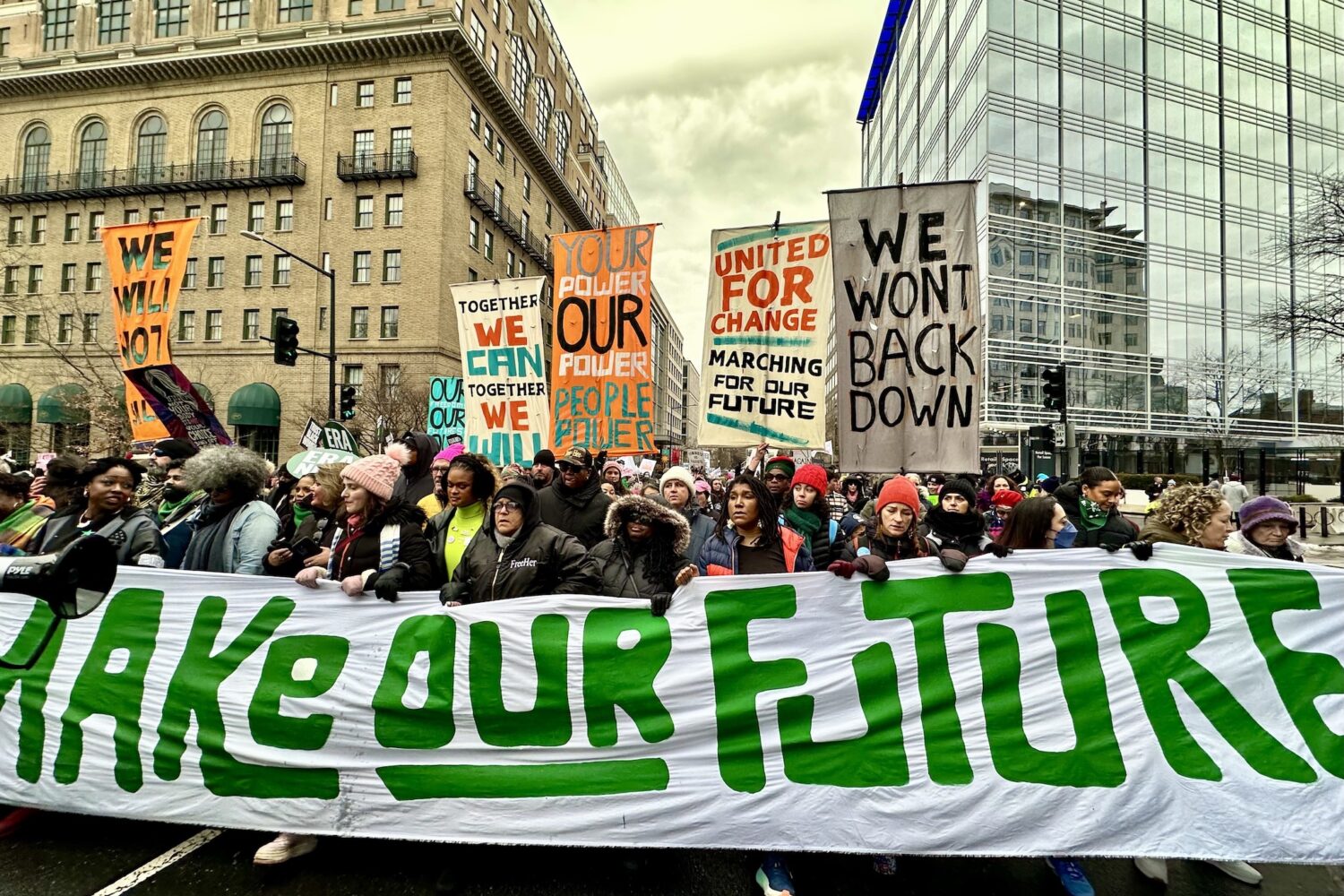Late on Saturday evening, Elizabeth Lansat stood facing the White House, alone and at some remove from the crowd, as she swayed to the hummed tunes of mourners. “When I first heard the news, I called my dad, because he went to high school in Pittsburgh. And I found out that, actually, he went to this synagogue as a student,” said Lansat, who is 26 and teaches special education. She told me she frequents Temple Or Chadash, in Damascus, Maryland, and had made the hourlong trip to the White House by herself—“To kind of pay respects,” Lansat said. Two tears rolled down each cheek, and the streaks caught glimmers of light from the stub of candle cupped between her palms. “My cousin is also a student at the University of Pittsburgh. Luckily, she wasn’t there this morning,” Lansat continued, dabbing her face with the heel of her hand. “It just hit a little close to home.”
The air was crisp and still, and the hazy aroma of burnt candlewicks lingered over the crowd. About 300 people had gathered in front of the White House to convene a vigil, held for 11 members of the Tree of Life (L’Simcha) Congregation who had been murdered hours earlier. On Saturday night, luminaries from Washington’s Jewish community led the crowd in song and prayer, addressing mourners from the dark center of a lagoon of candlelit faces. Organizers began with the Mourner’s Kaddish, honoring the dead; ended with the Havdalah service, welcoming the new week; and attempted to reckon, by turns somber and incensed, with the conduct of the man who occupied the residence directly behind them, and who was, at that moment, speeding directly toward them by helicopter, making his return from a campaign rally in Illinois.
According to reports, at around 10 AM on Saturday, a gunman—police identified him as 46-year-old Robert Bowers—entered the worship space in Pittsburgh’s Squirrel Hill neighborhood, and reportedly shouted anti-Semitic slurs as he opened fire with an AR-15-style rifle and at least three handguns. He remained inside for a nightmarish twenty minutes, after which, police say, Bowers left the building and exchanged gunfire with police officers, where he was wounded and apprehended. The Anti-Defamation League believes the attack is the deadliest on Jews in American history. Though Bowers’s alleged motive is still unknown, he had recently left vitriolic statements on social media. There, he appeared to source his rage to a partnership between Tree of Life and the Hebrew Immigrant Aid Society (HIAS), a refugee assistance organization based in Silver Spring. This past week, HIAS has been visiting 300 congregations for its National Refugee Shabbat, including Tree of Life.
Some who are familiar with Pittsburgh Jewry told me that Tree of Life is one of three small congregations that occupies a worship space in the building. Like those at Tree of Life, and many other Jews, I was raised in a small reform synagogue outside of Philadelphia that also shared its small worship space, a midcentury barn. And so while, I, too, had come to the vigil at the White House to mourn, I also made the trip out of curiosity—particularly to observe how Washington’s Jewish corners would react to the heinous and politically potent admixture of anti-Semitism, hatred of refugees, and yet another gun massacre.
The crowd tilted young. Some offered a glimpse into how Washington’s synagogues, organization, and Jewish families and students have begun to process the massacre. One, Alana Kessler, 22, a graduate student at American University, had joined nine others for a Shabat lunch Saturday afternoon at the campus Hillel, after some attended services at Adas Israel. Kessler, who was the first to learn among her friends, broke the news at the table. “We did the Havdalah service, which is supposed to start the new week,” Kessler said dolefully. “Obviously, it’s going to be a difficult week.”
At 8, staff from Ben the Arc, a left-leaning Jewish activist organization, led the Kaddish in call-and-response. They then passed the microphone around the crowd, where speakers from the National council of Jewish Women, the Religious Action Center for Reform Judaism, and Jews United for Justice were well represented—as well as a representative of the group Muslim Advocates.
“We’re here tonight to mourn. But we’re also here tonight to be angry,” said Nancy Kaufman, CEO of the National Council of Jewish women, who focused on the attack on refugees as well as Jews. She accused the Trump administration of creating a “sense of unwelcomeness to people who just want a better life.”
Two Pittsburghers from Squirrel Hill also approached the microphone. One, Josh Friedman, who wore an orange yarmulke and paced restlessly in a blue windbreaker and biker gloves, announced, “We need gun control. We need a leader that doesn’t incite violence,” to murmurs of approval. “It wasn’t my synagogue. But it was right down the street,” Friedman said. His voice cracked. “I did have to tell my three kids today that there was a mass shooting at the synagogue where they were last Sunday, at another event. And it could have been them.” He tilted his head back and cried out, away from the microphone, “I’m here filled with rage in my heart!”
Sarah Fierstein, a young woman wearing a raincoat and glasses, introduced herself as a lifelong member of Tree of Life. “I had my naming ceremony there. I had my bat mitzvah,” Fierstein told the crowd. “It’s been a place where it didn’t matter if you didn’t show up for two weeks; it didn’t’ matter if you didn’t show up for a year. You were welcomed with open arms.”
She explained the teenage protocol of pelting a newly minted b’nai mitzvah graduate with wrapped candy, to nervous laughter. “The rabbi who was doing my sister’s bat mitzvah service…he was very, very against that. Because he said that the synagogue was no place for that kind of violence,” Sarah said. “If that doesn’t show you what the synagogue stands for, I don’t know what does.” Fierstein said she knew some of the victims personally.
Then the microphone was passed to Miriam Feffer, a Jewish staffer with HIAS. “In times of mourning, Jews comfort each other by saying, ‘May their memory be for a blessing,’” Feffer began. “We are, and have always been, a refugee people,” she went on. “This is an old story. And a sad story. And unfortunately, a new chapter was written today.”
After a decade of intense demographic growth, greater Washington has become home to the third-largest population of Jews in the United States (behind New York and Los Angeles.) HIAS, one of the country’s nine largest refugee resettlement agencies, relocated its main offices to Silver Spring in 2014, when the organization ended its first 130 years headquartered in New York, beginning in 1881.
“At one point, we had an office right on Ellis Island, to catch people fresh of the boat,” Feffer told me after the vigil. In the 19th century, HIAS primarily resettled Jewish refugees fleeing Europe. One early volunteer was Emma Lazarus, years before she would write The New Colossus. “It’s a rich history,” said Feffer. At the turn of the last century, HIAS finished resettling the final wave of Soviet-era Jews. “We had a big decision to make,” Feffer said. “We could close up shop. Or we could turn our hundred years of experience and expertise to helping many millions of other people in need.”
Today, the organization coordinates resettlement programs for newly arrived refugees from locations in South and Central America, Southern Europe and East Africa. HIAS’s principal advantage, Feffer said, is its vast network of Jewish volunteers—congregation members who find refugees a place to live, drive them to appointments, babysit children when parents go for a job interview, or, as Lazarus did on East Broadway, train them personally in English and employment skills.
“HIAS used to help refugees because they were Jewish,” Feffer said. “Now we help them because we are Jewish.”
Tree of Life congregants had recently hosted a National Refugee Shabbat, Feffer said. But opportunities to resettle law-abiding refugees to the US—Bowers’s reported motivation for his attack—have rarely been fewer. Since 1980, the United States has led the world in refugee resettlement, typically through a presidential directive setting the annual limit at around 100,000 refugees, or three-fourths the world’s refugee population. This year, the United States set the limit at 45,000, and during that time, took only about 22,000. In the upcoming fiscal year, which begins October 31, the cap will be even lower: 35,000.
At the vigil, the focus was largely on refugee issues. One man, Teklit Michael, who stood proudly beside a HIAS staffer, told me he has was resettled to the United States two months ago after fleeing persecution in Eritrea. He spent the intermediate time in Israel. “I am not a Jew,” Michael said. “But I came here to stand with them in solidarity.”
Talk turned to anti-Semitism, then gun violence, then refugee issues, with dizzying ease—all with a pain fully magnified, it seemed, by the richness of the small network of east coast reform Jewry. One young activist, a Florida native named Aaron Torop, viewed the killing as an allegory about gun violence. He had lost a friend, a mutual camper at URJ Camp Coleman, the Jewish reform summer camp universally known to Sun Belt Jews, at the shooting at Marjory Stoneman Douglas High this past February.
Of all the younger millennials I encountered, not one recalled the last time that Washington woke up to news of an anti-Semitic attack—in 2009, when James von Brunn brought a rifle into the Holocaust Memorial, and killed an on-duty guard. (I didn’t even bother asking about the 1977 Hanafi siege.) Even as many seemed to grasp for a succinct political vocabulary—was it a catastrophe of anti-Semitism? Gun violence? Refugee hatred?—others scoured for meaning. One student at American, Jackson Pincus, had a particularly pressing issue at hand. “I have to teach Hebrew School at 9 AM,” Pincus told me. “And I have to figure out how to explain this to a bunch of sixth graders.”
For someone so young, Pincus struck me for the bitterness in his voice. “Anti-Semitism has been around for thousands of years. It’s not going to go away overnight. The best anyone can do is not make it worse,” Pincus said. “This didn’t start with Trump. But he’s making it a lot worse.”
From the White House gate, a piercing whistle sounded, and police officers began to shunt us off the street. “The President’s on his way home,” somebody guessed. (They were correct). With the remaining stragglers marooned on the curb, I found myself next to Barbara Weinstein, one of the evening’s speakers, from the Religious Action Center. How would Jews process the massacre? In the typology of gun massacres, like Parkland? Or anti-Semitic attacks, like von Brunn’s? Or perhaps in the Trump era, something else entirely?
“It’s hard to tease one over the other. You see incidents of hate, anti-Semitism, anti-LGBT, all on the rise,” Weinstein said. Instead, she offered up an impromptu midrash. “Today’s portion, read by Jews all over the world, is about the act of welcoming,” Weinstein said. “Abraham is sitting in his tent, under the shelter from the beating sun. He sees visitors walking by. He doesn’t just say come in, but gets up, runs to meet them, and welcomes them into his tent.”
“How extraordinarily painful that this morning, as worshippers gathered in their synagogue, a visitor came and caused havoc and destruction and loss of life,” she went on. “How painful for all of us as a Jewish community, as Americans who lived with the burden of the growing and unceasing acts of violence.”
The last officer padded in front of us, unfurling a ribbon of yellow DO NOT CROSS tape behind him, as the din of a landing helicopter echoed nearby. Weinstein shrugged, then grimaced.
“May their memory be for a blessing.”



















